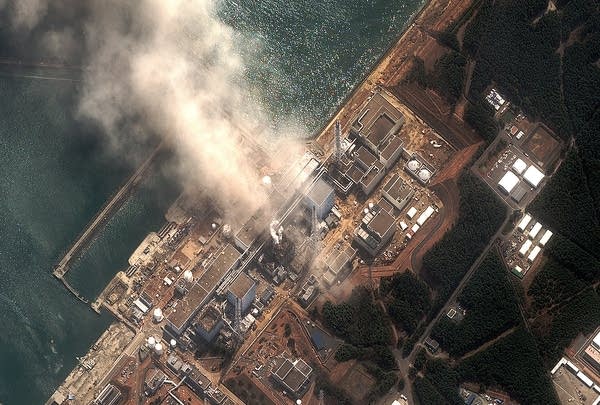Japan considers spraying water, acid into reactors
Go Deeper.
Create an account or log in to save stories.
Like this?
Thanks for liking this story! We have added it to a list of your favorite stories.

By ERIC TALMADGE and SHINO YUASA, Associated Press
KORIYAMA, Japan (AP) — Japan was considering spraying water and boric acid over a stricken nuclear plan in a desperate measure to contain radiation after officials said Wednesday that many fuel roads were damaged, in an escalating crisis caused by last week's earthquake and tsunami.
Masami Nishimura, a spokesman for Japan's nuclear safety agency, said the plant's operator, Tokyo Electric Power Co., thought of the measures after a string of explosions and fires at the Fukushima Dai-ichi nuclear power plant.
The latest fire broke out at a reactor early Wednesday, a day after the power plant emitted a burst of radiation that panicked an already edgy Japan following Friday's massive earthquake and tsunami that is estimated to have killed more than 10,000 people.
Turn Up Your Support
MPR News helps you turn down the noise and build shared understanding. Turn up your support for this public resource and keep trusted journalism accessible to all.
Hajimi Motujuku, a spokesman for Tokyo Electric Power, or TEPCO, said the outer housing of the containment vessel at the No. 4 unit at the complex caught fire.
On Tuesday, a fire broke out in the same reactor's fuel storage pond - an area where used nuclear fuel is kept cool - causing radioactivity to be released into the atmosphere. TEPCO said the new blaze erupted because the initial fire had not been fully extinguished.
About three hours after the blaze erupted Wednesday, Japan's nuclear safety agency said flames could no longer be seen at Unit 4. But it was unable to confirm that the blaze had been put out, and clouds of white smoke were billowing from the reactor, according to live video footage of the plant.
Also Wednesday, Japan's nuclear safety agency said 70 percent of the nuclear fuel rods may have been damaged at another Fukushima Dai-ichi reactor that was first stricken last week, triggering the crisis.
"But we don't know the nature of the damage, and it could be either melting, or there might be some holes in them," said an agency spokesman, Minoru Ohgoda.
Japan's national news agency, Kyodo, said 33 percent of the fuel rods at a second reactor were also damaged.
The troubles have been caused by overheating of the reactors, which have lost their cooling ability because of damage to equipment from the earthquake and tsunami. Excessive heating will lead to a meltdown of the reactor and release hazardous radiation.
Engineers are desperately trying to cool the reactors and spent fuel rods after the electricity was cut off in the wake of the quake, shutting down their cooling functions.
Boric acid is "important because it captures radiation and helps prevent radiation from leaking," said Nishimura, the safety agency spokesman.
He said the government had also ordered the utility company to immediately spray water on Unit 4.
Both units 1 and 3 have no roof after earlier blasts, making it easy to dump water onto them, he said. Unit 4 has holes in the building, allowing fire trucks to spray water inside, he said.
Boric acid contains boron, which helps slow nuclear reactions by absorbing neutrons, said Naj Meshkati, a nuclear power plant safety expert at the University of Southern California. But the same acid also melted away steel when it was used repeatedly at a troubled northern Ohio nuclear plant.
Radiation levels in areas around the nuclear plant rose early Tuesday afternoon but appeared to subside by evening, officials said. But the unease remained in a country trying to recover from the massive disasters that are believed to have killed more than 10,000 people and battered the world's third-largest economy.
The radiation leak caused the government to order 140,000 people living within 20 miles (30 kilometers) of the plant to seal themselves indoors to avoid exposure, and authorities declared a ban on commercial air traffic through the area. Worries about radiation rippled through Tokyo and other areas far beyond that cordon. The stock market plunged for a second straight day, dropping 10 percent Tuesday. However, the market soared more than 6 percent in Wednesday morning trading.
The re-emergence of the fire at the spent fuel pond in Unit 4 makes that "my biggest worry" because "the spent fuel pool really doesn't have any containment over it and it's very exposed," said Meshkati. "There is radioactive fuel that could cause some problems."
The fire could put all sorts of radioactive isotopes - such as cesium and iodine - into the air, Meshkati said.
(Copyright 2011 by The Associated Press. All Rights Reserved.)







